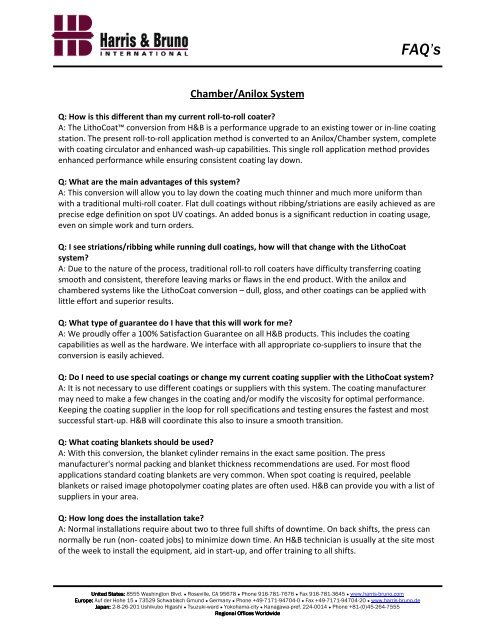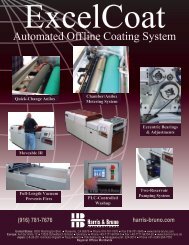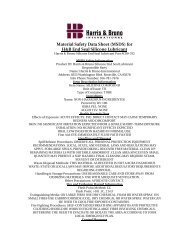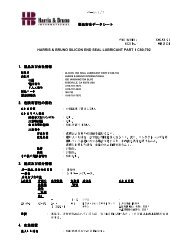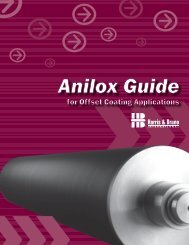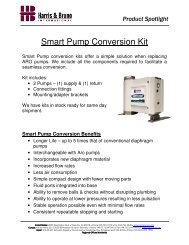Chamber/Anilox System - Harris & Bruno
Chamber/Anilox System - Harris & Bruno
Chamber/Anilox System - Harris & Bruno
You also want an ePaper? Increase the reach of your titles
YUMPU automatically turns print PDFs into web optimized ePapers that Google loves.
<strong>Chamber</strong>/<strong>Anilox</strong> <strong>System</strong><br />
FAQ’s<br />
Q: How is this different than my current roll-to-roll coater?<br />
A: The LithoCoat conversion from H&B is a performance upgrade to an existing tower or in-line coating<br />
station. The present roll-to-roll application method is converted to an <strong>Anilox</strong>/<strong>Chamber</strong> system, complete<br />
with coating circulator and enhanced wash-up capabilities. This single roll application method provides<br />
enhanced performance while ensuring consistent coating lay down.<br />
Q: What are the main advantages of this system?<br />
A: This conversion will allow you to lay down the coating much thinner and much more uniform than<br />
with a traditional multi-roll coater. Flat dull coatings without ribbing/striations are easily achieved as are<br />
precise edge definition on spot UV coatings. An added bonus is a significant reduction in coating usage,<br />
even on simple work and turn orders.<br />
Q: I see striations/ribbing while running dull coatings, how will that change with the LithoCoat<br />
system?<br />
A: Due to the nature of the process, traditional roll-to roll coaters have difficulty transferring coating<br />
smooth and consistent, therefore leaving marks or flaws in the end product. With the anilox and<br />
chambered systems like the LithoCoat conversion – dull, gloss, and other coatings can be applied with<br />
little effort and superior results.<br />
Q: What type of guarantee do I have that this will work for me?<br />
A: We proudly offer a 100% Satisfaction Guarantee on all H&B products. This includes the coating<br />
capabilities as well as the hardware. We interface with all appropriate co-suppliers to insure that the<br />
conversion is easily achieved.<br />
Q: Do I need to use special coatings or change my current coating supplier with the LithoCoat system?<br />
A: It is not necessary to use different coatings or suppliers with this system. The coating manufacturer<br />
may need to make a few changes in the coating and/or modify the viscosity for optimal performance.<br />
Keeping the coating supplier in the loop for roll specifications and testing ensures the fastest and most<br />
successful start-up. H&B will coordinate this also to insure a smooth transition.<br />
Q: What coating blankets should be used?<br />
A: With this conversion, the blanket cylinder remains in the exact same position. The press<br />
manufacturer's normal packing and blanket thickness recommendations are used. For most flood<br />
applications standard coating blankets are very common. When spot coating is required, peelable<br />
blankets or raised image photopolymer coating plates are often used. H&B can provide you with a list of<br />
suppliers in your area.<br />
Q: How long does the installation take?<br />
A: Normal installations require about two to three full shifts of downtime. On back shifts, the press can<br />
normally be run (non- coated jobs) to minimize down time. An H&B technician is usually at the site most<br />
of the week to install the equipment, aid in start-up, and offer training to all shifts.<br />
United United United States: States: 8555 Washington Blvd. ● Roseville, CA 95678 ● Phone 916-781-7676 ● Fax 916-781-3645 ● www.harris-bruno.com<br />
Europe: Europe: Auf der Hohe 15 ● 73529 Schwabisch Gmund ● Germany ● Phone +49-7171-94704-0 ● Fax +49-7171-94704-20 ● www.harris-bruno.de<br />
Japan: Japan: 2-8-26-201 Ushikubo Higashi ● Tsuzuki-ward ● Yokohama-city ● Kanagawa-pref. 224-0014 ● Phone +81-(0)45-264-7555<br />
Regional Offices Worldwide
Q: Can I specify this equipment on my new press purchase?<br />
A: This system can be ordered through the press manufacturer on a new machine or purchased as a<br />
retrofit to an existing press.<br />
Q: On what Offset press types can this unit be installed?<br />
A: The H&B LithoCoat system has been installed on most popular machine types, including: Komori,<br />
Mitsubishi, Heidelberg, MAN Roland, KBA Planeta, Sakurai, and others.<br />
FAQ’s<br />
Q: I have an add-on blanket coater, can this be converted to the LithoCoat technology?<br />
A: In most cases an existing blanket coater can be converted to include a ceramic anilox roll and the<br />
chambered doctor blade system. Improvements in performance along with faster clean-ups and less<br />
slinging can be expected.<br />
Q: What is an anilox roll?<br />
A: The anilox roll is simply a metering roll designed to consistently supply a uniform and measurable<br />
volume of liquid. Using a computer-controlled laser, millions of microscopic holes (or cells) are vaporized<br />
into the surface of the ceramic coating of the anilox roll. These cells are what actually cups and carries<br />
the coating to the blanket or plate cylinder.<br />
Q: What rolls are removed and how is the new anilox driven?<br />
A: The smooth chrome or rubber application roll presently in the press is removed and replaced with<br />
anilox roll of exactly the same physical dimensions. Depending on press type, split cap journals are<br />
installed to speed future roll changes. The existing press drive is re-used to maintain an exact surface<br />
speed match between the new anilox roll and the blanket cylinder. All of the other transfer rolls in the<br />
coater are removed.<br />
Q: Can I run with just one anilox roll or do I need to change rolls with every coating?<br />
A: A typical printer will usually require one roll that can be run with all of their coatings. However, if<br />
major variances in coating weight are required (example: switching from a flood work and turn to a<br />
blister coating) an additional roll with a different engraving may be required. A spare roll is also smart to<br />
have on hand.<br />
Q: I hear of steel, aluminum, carbon fiber, chrome & ceramic anilox rolls. What’s the best choice?<br />
A: The core of the anilox roll can be made of steel or lighter-weight aluminum and carbon fiber. The<br />
downside to carbon fiber is a higher cost. Aluminum is half the cost of carbon fiber, can be re-engraved<br />
more times than carbon fiber, and is still light enough to be lifted without a hoist. All cores are ceramic<br />
coated and then laser engraved to exact specifications for the application. Mechanically engraved<br />
chrome rolls were used in the past, but industry experts agree that ceramic offers superior performance,<br />
accuracy and wear resistance. H&B only uses ceramic surface rolls.<br />
Q: How do I determine the proper anilox volume?<br />
A: As part of the complete package, H&B guarantees to supply the proper anilox roll for the application.<br />
We also offer the use of banded rolls (rolls with different volumes) to help in testing and ultimately<br />
deciding what the exact engraving should be.<br />
United United United States: States: 8555 Washington Blvd. ● Roseville, CA 95678 ● Phone 916-781-7676 ● Fax 916-781-3645 ● www.harris-bruno.com<br />
Europe: Europe: Auf der Hohe 15 ● 73529 Schwabisch Gmund ● Germany ● Phone +49-7171-94704-0 ● Fax +49-7171-94704-20 ● www.harris-bruno.de<br />
Japan: Japan: 2-8-26-201 Ushikubo Higashi ● Tsuzuki-ward ● Yokohama-city ● Kanagawa-pref. 224-0014 ● Phone +81-(0)45-264-7555<br />
Regional Offices Worldwide
FAQ’s<br />
Q: What are the terms used when discussing anilox engraving specifications?<br />
A: There are 3 major characteristics in determining how the cells are engraved:<br />
• Line Screen (l.s.): The number of actual cells measured in one linear inch.<br />
• Cell Volume (bcm): The volume of one square inch of cells measured in billion cubic microns.<br />
• Angle of Engraving: Angle in which cells are engraved in relation to the centerline axis of the roll.<br />
A typical roll might be identified as: (180 l.s. 11.0 bcm 60 degree).<br />
United United United States: States: 8555 Washington Blvd. ● Roseville, CA 95678 ● Phone 916-781-7676 ● Fax 916-781-3645 ● www.harris-bruno.com<br />
Europe: Europe: Auf der Hohe 15 ● 73529 Schwabisch Gmund ● Germany ● Phone +49-7171-94704-0 ● Fax +49-7171-94704-20 ● www.harris-bruno.de<br />
Japan: Japan: 2-8-26-201 Ushikubo Higashi ● Tsuzuki-ward ● Yokohama-city ● Kanagawa-pref. 224-0014 ● Phone +81-(0)45-264-7555<br />
Regional Offices Worldwide


